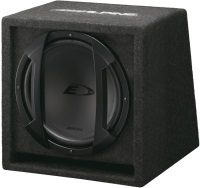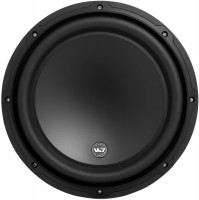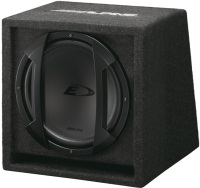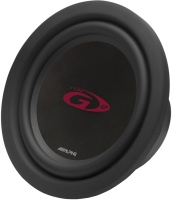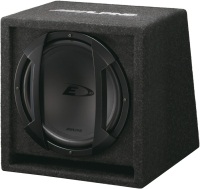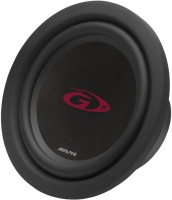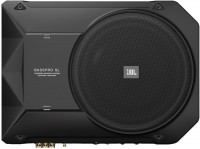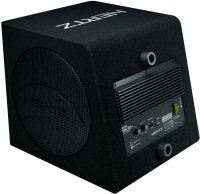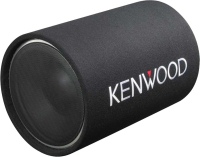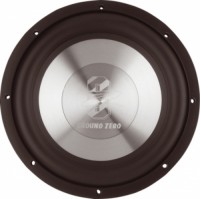Car Subwoofers Ground Zero
All Car Subwoofers Advanced filters → |
You might be interested in
Car Subwoofers: specifications, types
Application area
— Automotive. Subwoofers designed for use in the car; usually they do not have protection from adverse external conditions (splash, salt, etc.), this is their main difference from "seaworthy" models. Other features and functions may vary significantly from model to model.
— Navigation. Subwoofers for which the possibility of installation on a water vehicle (boat or yacht) is provided, including and in an open cabin. They differ from conventional automotive counterparts primarily in their impenetrable body, protected from splashes and salt. If desired, such a subwoofer can also be installed in a car, but usually it justifies itself only on specialized SUVs that regularly stay in extreme conditions.
— Navigation. Subwoofers for which the possibility of installation on a water vehicle (boat or yacht) is provided, including and in an open cabin. They differ from conventional automotive counterparts primarily in their impenetrable body, protected from splashes and salt. If desired, such a subwoofer can also be installed in a car, but usually it justifies itself only on specialized SUVs that regularly stay in extreme conditions.
OEM car subwoofer
Car models for which the regular auto subwoofer is intended.
Regular models can be made both for a specific brand and for a fairly extensive model range, including cars from different manufacturers. However, anyway, it is worth remembering that even the same car model can have several versions that differ in design features. Therefore, when buying a regular car subwoofer, it's ok to separately clarify its actual compatibility with a particular car, even if this model is indicated in the model specifications.
Regular models can be made both for a specific brand and for a fairly extensive model range, including cars from different manufacturers. However, anyway, it is worth remembering that even the same car model can have several versions that differ in design features. Therefore, when buying a regular car subwoofer, it's ok to separately clarify its actual compatibility with a particular car, even if this model is indicated in the model specifications.
Design
— In the body. Subwoofers consisting of a full-fledged enclosure in which the speaker (speakers) is installed. Usually they are designed to be installed in the boot. Cabinet models are easy to install, but take up a significant amount of space, and in most cases have some phase delay that requires phase adjustment (see below) to synchronize with the front speakers.
— Without body. This category includes subwoofers designed to work in their own cabinet, but not equipped with it (not to be confused with Free Air — see below). Thus, having bought such a speaker, you can choose a case for it at your discretion — or even make it yourself. This, of course, is more difficult than immediately acquiring a cabinet “subwoofer”, however, it gives more opportunities for adjusting the acoustics to personal preferences. Other advantages and disadvantages of frameless models are similar to case models.
— Without body (Free Air). Car subwoofers of this type are not only not equipped with a case, but they do not imply its use at all: usually Free Air models are designed for installation in the rear shelf or back of the rear seat, and the boot plays the role of the case. The advantages of such an installation are the minimum space occupied (which is important with small boot volumes), as well as the almost complete absence of delay and the ease of “docking” with the main c...hannels of the audio system. On the other hand, installing a Free Air subwoofer in itself is associated with a number of difficulties. For example, for the effective operation of such a speaker, the boot must be hermetically separated from the passenger compartment; it is quite difficult to provide such conditions, and in some body types (for example, station wagons) it is almost impossible. In addition, such a speaker has much less ability to adjust to a specific interior than a cabinet one; and with a tightly loaded boot, the sound characteristics deteriorate noticeably. Therefore, paying attention to such “subs” is primarily for owners of sedans who do not have to carry a lot of luggage.
— Without body. This category includes subwoofers designed to work in their own cabinet, but not equipped with it (not to be confused with Free Air — see below). Thus, having bought such a speaker, you can choose a case for it at your discretion — or even make it yourself. This, of course, is more difficult than immediately acquiring a cabinet “subwoofer”, however, it gives more opportunities for adjusting the acoustics to personal preferences. Other advantages and disadvantages of frameless models are similar to case models.
— Without body (Free Air). Car subwoofers of this type are not only not equipped with a case, but they do not imply its use at all: usually Free Air models are designed for installation in the rear shelf or back of the rear seat, and the boot plays the role of the case. The advantages of such an installation are the minimum space occupied (which is important with small boot volumes), as well as the almost complete absence of delay and the ease of “docking” with the main c...hannels of the audio system. On the other hand, installing a Free Air subwoofer in itself is associated with a number of difficulties. For example, for the effective operation of such a speaker, the boot must be hermetically separated from the passenger compartment; it is quite difficult to provide such conditions, and in some body types (for example, station wagons) it is almost impossible. In addition, such a speaker has much less ability to adjust to a specific interior than a cabinet one; and with a tightly loaded boot, the sound characteristics deteriorate noticeably. Therefore, paying attention to such “subs” is primarily for owners of sedans who do not have to carry a lot of luggage.
Enclosure type
— Closed box. The simplest type of case: a box closed on all sides with a speaker (speakers) on the front panel. The advantages of such models are high accuracy of sound transmission and low cost, the disadvantages are low sensitivity and somewhat “flat” bass.
— Phase inverter. A classic phase inverter is a hollow tube connecting the internal volume of the case with the outside world (however, there are other options for such a connection). The length of the phase inverter channel is chosen so that the sound waves of a certain range, passing through it, are inverted in phase relative to the waves from the speaker (hence the name). This improves (in particular, "deepens") the sound of the subwoofer and allows you to achieve good performance with a small cabinet size. On the other hand, the sound stream in the tube creates a certain additional noise.
— Strip. A design that combines the features of a closed box and a bass-reflex enclosure. One of its parts is made closed, and the second is equipped with a phase inverter tube; between them is a partition, on which the main speaker is located. Unlike previous types, the speaker is entirely inside the case. Strip-line enclosures provide louder sound than boxes or bass reflexes, with sound quality comparable to the latter. The disadvantage is the complexity of the design, as a result — a slightly higher price.
— Phase inverter. A classic phase inverter is a hollow tube connecting the internal volume of the case with the outside world (however, there are other options for such a connection). The length of the phase inverter channel is chosen so that the sound waves of a certain range, passing through it, are inverted in phase relative to the waves from the speaker (hence the name). This improves (in particular, "deepens") the sound of the subwoofer and allows you to achieve good performance with a small cabinet size. On the other hand, the sound stream in the tube creates a certain additional noise.
— Strip. A design that combines the features of a closed box and a bass-reflex enclosure. One of its parts is made closed, and the second is equipped with a phase inverter tube; between them is a partition, on which the main speaker is located. Unlike previous types, the speaker is entirely inside the case. Strip-line enclosures provide louder sound than boxes or bass reflexes, with sound quality comparable to the latter. The disadvantage is the complexity of the design, as a result — a slightly higher price.
Body shape
— Case Box. Literally "box". The simplest type of case, in fact, is a box of medium dimensions, designed for installation in the boot.
— Compact. This option means rather than the shape, but the size of the case — as the name implies, it includes devices that have small dimensions. Such subwoofers are as simple as possible to install, some models can be installed directly under the seat. At the same time, their sound quality and power are usually lower than those of full-size ones.
— Tube. The case is in the form of a pipe, on one of the ends of which a speaker is displayed. This form does not significantly affect the sound characteristics, it plays mainly an aesthetic role — subwoofers-pipes look quite stylish.
— Compact. This option means rather than the shape, but the size of the case — as the name implies, it includes devices that have small dimensions. Such subwoofers are as simple as possible to install, some models can be installed directly under the seat. At the same time, their sound quality and power are usually lower than those of full-size ones.
— Tube. The case is in the form of a pipe, on one of the ends of which a speaker is displayed. This form does not significantly affect the sound characteristics, it plays mainly an aesthetic role — subwoofers-pipes look quite stylish.
Type
— Active. Subwoofer equipped with its own built-in amplifier. Such a subwoofer can be connected directly to the signal source, without any additional amplifiers; while the built-in amplifier, by definition, has characteristics that best match the parameters of the speaker. And when using other amplifiers, an active subwoofer reduces the load on them, which has a positive effect on sound quality and power. In addition, your own amplifier can be equipped with its own sound tuning tools and other additional features. On the other hand, all this affects the cost of the device, and active models are somewhat more difficult to install, because. require separate power supply.
— Passive. Subwoofers not equipped with their own amplifier. They are cheaper than active ones and easier to install. work without a separate power supply, however, the connection is fraught with some difficulties: for normal operation, an amplifier is needed, the characteristics of which (in particular power and impedance, see below) must optimally match the parameters of the subwoofer.
— Passive. Subwoofers not equipped with their own amplifier. They are cheaper than active ones and easier to install. work without a separate power supply, however, the connection is fraught with some difficulties: for normal operation, an amplifier is needed, the characteristics of which (in particular power and impedance, see below) must optimally match the parameters of the subwoofer.
Size
The size (diameter) of the main subwoofer speaker. In all types of subwoofers, this parameter primarily affects the power and depth of sound: the larger the speaker, the louder it is and the deeper the bass it can provide (ceteris paribus). However with an increase in the size and dimensions, they increase accordingly, which determines the installation possibilities. The latter is especially true in Free Air subwoofers (see "Execution"): some cars are initially equipped with "seats" for a certain size, and it is difficult to install models with other dimensions there.
Now on the market there are subwoofers with such popular sizes: 5" (13 cm), 6" (15.25 cm), 6.3" (16 cm), 6.5" (16.5 cm), 6.75" (17 cm), 8" (20 cm ), 8.25"(21cm) , 9" (23cm ), 10" (25cm ), 11" (27cm), 12"(30cm) , 13" (33cm), 15"(38cm) , 16 " (40 cm), 18" (46 cm).
Now on the market there are subwoofers with such popular sizes: 5" (13 cm), 6" (15.25 cm), 6.3" (16 cm), 6.5" (16.5 cm), 6.75" (17 cm), 8" (20 cm ), 8.25"(21cm) , 9" (23cm ), 10" (25cm ), 11" (27cm), 12"(30cm) , 13" (33cm), 15"(38cm) , 16 " (40 cm), 18" (46 cm).
Number of woofers
The number of main speakers installed in the subwoofer. Most models are equipped with a single speaker, which is considered sufficient for quite decent bass reproduction. Models with two speakers sound louder and have better sensitivity, but are complex in design (as a result, more expensive) and more difficult to install, and therefore are relatively rare.
Radiator
The presence in the subwoofer design of the so-called passive radiator (radiator). The radiator is actually a separate hole with a low-frequency diffuser installed in it, in other words, the same speaker, but without a coil and a magnet, due to which the radiator does not reproduce the sound itself, but only improves the sound of the subwoofer's own speaker. The radiator is usually installed in cases of the "Closed box" type (see "Case type"), and its purpose and sound features are similar to the phase inverter (see ibid.), with the difference that the radiator is devoid of one of the main drawbacks of the phase inverter — air noise in tube. Yes, and the size of such models in thickness is noticeably smaller.
Rated power
The average (root mean square — RMS) power of the input signal, at which the subwoofer is able to work continuously without negative consequences (damage, failure) for at least an hour. The rated power of the subwoofer must be greater than the power of the amplifier connected to it — in order to avoid overloads.
Max. power
The maximum signal power that the subwoofer is able to withstand for a short time (up to several seconds) without any negative consequences. When selecting an amplifier-subwoofer pair, it is recommended to take a subwoofer with a maximum power of at least twice the maximum power of the amplifier. In general, the higher the maximum power, the more resistant the subwoofer is to overloads.
Frequency range
The range of audio frequencies reproduced by the subwoofer. It is believed that the human ear is capable of perceiving a frequency range of the order of 16 – 20,000 Hz, but in this case note that the subwoofer is designed to reproduce the lower frequency band (up to 200 Hz). Accordingly, in the case of the lower limit of the range, everything is simple: “the lower, the better”; the upper one should not be lower than the lower limit of the main car audio — otherwise there will be "gaps" in the frequencies, which will affect the sound quality.
Sensitivity
Sensitivity determines the loudness of the subwoofer when a signal of a certain power is connected to it: with equal signal power and impedance (see below), the subwoofer with the higher sensitivity will sound louder.
Dual voice coil
A dual voice coil is actually two separate voice coils on the same speaker. This allows you to connect two amplifiers to the subwoofer at once, thus providing high sound power.
Impedance
The electrical resistance of a subwoofer when a signal is applied to it. This parameter is important primarily for selecting a subwoofer-amplifier pair: at a lower impedance than that of the amplifier, the subwoofer will distort the sound, at a higher impedance the sound will be too quiet.
For dual voice coil models (see above), the impedance is specified for one of the voice coils.
For dual voice coil models (see above), the impedance is specified for one of the voice coils.
Resonant frequency
The natural frequency of the cone in the subwoofer speaker, namely the frequency with which the cone will oscillate if the speaker is suspended freely in the air and a single impulse is transmitted to the cone (for example, by clicking on it with your finger). In subwoofers, this parameter determines, in particular, the lower limit of the frequency range (see above): at frequencies below the resonant sound power drops sharply. Accordingly, for deep rich bass, the resonant frequency should be as low as possible. This parameter is also used to calculate the size of the enclosure for the subwoofer.
Bass level control
Since the subwoofer was originally designed to reproduce bass, in fact, in this case, it implies the presence of its own volume control, which allows you to change it without affecting the signal source. This allows you to easily set the desired bass level relative to the rest of the sound of the audio system (for different cases, this ratio may be different).
Phase control
The ability to change the phase of the sound coming from the subwoofer, in other words, the ability to adjust the sound from the subwoofer to lead or lag relative to the main speakers. This need may be due to the fact that the sound from the main speakers and from the subwoofer can reach the listener with different delays — due to the location of the speakers and the features of the electronics — which negatively affects the sound quality. Adjusting the phases allows you to harmonize this sound. This feature is usually found in active subwoofers.
Subsonic filter
The presence in the subwoofer of an infra-low frequency filter (Finch), also referred to as Subsonic. This filter "cuts" subsonic frequencies, preventing the subwoofer from reproducing them. Often this filter has a frequency control. This feature serves several purposes. Firstly, the human ear is no longer able to recognize such vibrations, and there is no point in reproducing them — this only leads to useless expenditure of energy. Secondly, intense infrasound can adversely affect well-being (both physical and mental). Thirdly, working with infra-low frequencies at high power can damage the subwoofer itself: figuratively speaking, the coil “blows” off the speaker.
High voltage input
The presence of a high-voltage input at the active (see "Type") subwoofer. Such an input greatly expands the possibilities for connection. Usually active subwoofers are connected via a linear (low-voltage) input directly to the radio. The high-voltage input allows you to connect the speaker to a separate power amplifier, like a passive subwoofer.
Gold plated contacts
The presence of gold plating on the subwoofer connectors. Such a coating is not only aesthetically pleasing, but above all it is resistant to oxidation, has low electrical resistance and ensures reliable contact, thus minimizing interference from the connection point.
Remote control
The remote control allows you to control the functions of the subwoofer from a distance. This is especially useful if the device is installed in the boot or otherwise difficult to access — you can easily change settings without access to the subwoofer itself, including while the car is moving.
Protective grille
The presence of protective devices in front of the main speaker of the subwoofer — this can be the grill itself, metal rods, plastic elements, etc. Such devices protect the device from foreign objects to a certain extent, and they can also play an aesthetic role.
Plexiglass insert
The presence of a transparent insert in the subwoofer housing. Such an insert does not affect the sound quality and characteristics, however, it gives the device an original appearance.
Enclosures illumination
The presence of its own backlight on the subwoofer case. The role of this function is purely decorative: it does not affect the sound characteristics, but it provides a stylish design.
Diffuser material
The material from which the speaker cone in the subwoofer is made. Determines the sound quality and, to some extent, the cost of the device.
— Pulp/paper. Historically the first diffuser material. Its advantages are lightness (which ensures high speaker sensitivity), as well as a smooth frequency response (amplitude-frequency response), which positively affects the sound quality. Among the shortcomings — low strength, which limits the power of such subwoofers, as well as softness, somewhat "blurring" the sound in difficult moments. In addition, paper diffusers are sensitive to moisture.
— Polypropylene. Synthetic polymer, in some aspects similar to paper, but differing from it in higher strength and resistance to moisture. It also has a smooth frequency response. Somewhat more cruel, but still belongs to the soft.
— Polyurethane. Another polymer material. At a low cost, it is somewhat stiffer than polypropylene, and is also very resistant to mechanical stress, which allows you to create powerful speakers.
— Kevlar. Kevlar fibre is highly durable (higher than steel); it also has good rigidity, which has a positive effect on fidelity in difficult moments. However, such diffusers are not cheap.
— Carbon fibre. It belongs to premium materials: it has high strength at a very low weight, and in the case of subwoofers, it is also worth mentioning the good rigidity that ensures a clear sound. Among the shortcomings — a somew...hat uneven frequency response and an impressive cost.
— Carbon. Another name used for carbon fibre is mainly for promotional purposes, for brevity and “impressiveness” of sound. See above for more details on carbon fibre.
— Fibreglass. Such material consists of ordinary glass stretched into filaments; unlike the classical form of glass, such threads do not break or break. It's lightweight (respectively sensitive), relatively cheap, resistant to moisture and temperature changes, and still provides good (though not outstanding) sound quality.
— Composite materials. Composite is a material that consists of two or more materials with a clear separation between them. In subwoofer cones, carbon fibre composites (based on carbon fibre, see above) are most often used. Such diffusers have all the advantages of carbon fibre and are able to provide good sound quality — however, due to the characteristics of the frequency response of the material, rather complex electronic circuits have to be used to achieve this quality, which affects, in particular, the price of subwoofers.
— Aluminium. Aluminium cones have the highest rigidity of all, which ensures high fidelity of sound transmission even in difficult moments. The "reverse side of the coin" in this case are their own extraneous "ringing" that occurs in the diffuser. To eliminate them, you have to use various tricks that significantly complicate the design and increase the price of the subwoofer.
Note that each material has its own characteristics and shades of sound, which you should pay attention to when choosing — a more expensive and high-quality material will not necessarily give a sound that you personally will like more.
— Pulp/paper. Historically the first diffuser material. Its advantages are lightness (which ensures high speaker sensitivity), as well as a smooth frequency response (amplitude-frequency response), which positively affects the sound quality. Among the shortcomings — low strength, which limits the power of such subwoofers, as well as softness, somewhat "blurring" the sound in difficult moments. In addition, paper diffusers are sensitive to moisture.
— Polypropylene. Synthetic polymer, in some aspects similar to paper, but differing from it in higher strength and resistance to moisture. It also has a smooth frequency response. Somewhat more cruel, but still belongs to the soft.
— Polyurethane. Another polymer material. At a low cost, it is somewhat stiffer than polypropylene, and is also very resistant to mechanical stress, which allows you to create powerful speakers.
— Kevlar. Kevlar fibre is highly durable (higher than steel); it also has good rigidity, which has a positive effect on fidelity in difficult moments. However, such diffusers are not cheap.
— Carbon fibre. It belongs to premium materials: it has high strength at a very low weight, and in the case of subwoofers, it is also worth mentioning the good rigidity that ensures a clear sound. Among the shortcomings — a somew...hat uneven frequency response and an impressive cost.
— Carbon. Another name used for carbon fibre is mainly for promotional purposes, for brevity and “impressiveness” of sound. See above for more details on carbon fibre.
— Fibreglass. Such material consists of ordinary glass stretched into filaments; unlike the classical form of glass, such threads do not break or break. It's lightweight (respectively sensitive), relatively cheap, resistant to moisture and temperature changes, and still provides good (though not outstanding) sound quality.
— Composite materials. Composite is a material that consists of two or more materials with a clear separation between them. In subwoofer cones, carbon fibre composites (based on carbon fibre, see above) are most often used. Such diffusers have all the advantages of carbon fibre and are able to provide good sound quality — however, due to the characteristics of the frequency response of the material, rather complex electronic circuits have to be used to achieve this quality, which affects, in particular, the price of subwoofers.
— Aluminium. Aluminium cones have the highest rigidity of all, which ensures high fidelity of sound transmission even in difficult moments. The "reverse side of the coin" in this case are their own extraneous "ringing" that occurs in the diffuser. To eliminate them, you have to use various tricks that significantly complicate the design and increase the price of the subwoofer.
Note that each material has its own characteristics and shades of sound, which you should pay attention to when choosing — a more expensive and high-quality material will not necessarily give a sound that you personally will like more.
Material
— MDF. Abbreviation for medium density fiberboard, i.e. medium density fibreboard. This material is inexpensive, easy to process and has a uniform structure, which is important for speaker cabinets. As a result, most modern cabinet subwoofers are made from MDF.
— Resin. It is used in cases where a complex shape is needed, which is difficult to reproduce when using MDF, as well as in compact models (see "Body shape"). In addition, it has no significant advantages over MDF, and therefore is used very rarely.
— Aluminium. Aluminium is light, homogeneous, and also conducts heat well, which allows you to install powerful speakers in such cases without fear of overheating. In addition, it has an elegant appearance. On the other hand, such cases cost accordingly.
— Plastic. Relatively inexpensive and easy to process material, which, at the same time, is available in different grades and may have different properties. Due to this, plastic enclosures are found in both relatively inexpensive and fairly advanced subwoofers; the sound quality of such a subwoofer depends mainly on its general price category.
— Resin. It is used in cases where a complex shape is needed, which is difficult to reproduce when using MDF, as well as in compact models (see "Body shape"). In addition, it has no significant advantages over MDF, and therefore is used very rarely.
— Aluminium. Aluminium is light, homogeneous, and also conducts heat well, which allows you to install powerful speakers in such cases without fear of overheating. In addition, it has an elegant appearance. On the other hand, such cases cost accordingly.
— Plastic. Relatively inexpensive and easy to process material, which, at the same time, is available in different grades and may have different properties. Due to this, plastic enclosures are found in both relatively inexpensive and fairly advanced subwoofers; the sound quality of such a subwoofer depends mainly on its general price category.
Woofer Diameter
Subwoofer main speaker size. The diameter of the woofer determines the size of the device (see above).
Woofer Depth
The size of the subwoofer's main speaker from the front (usually the bezel that protrudes beyond the cone) to the rear edge (where the magnet is usually located). In fact, it matters when selecting cases for frameless models, as well as installing Free Air (see "Execution"): it is at this depth that the speaker will be "drowned" in the case or in the boot. And not always a flat subwoofer will produce less bass than its more voluminous counterpart.

